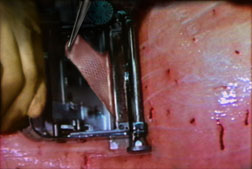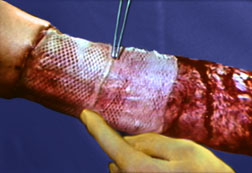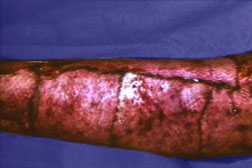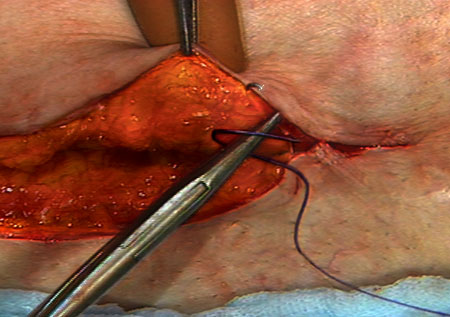باز آفرینی علم و هنر Dentistry & Medicine
علم امروز و هنر دیروزباز آفرینی علم و هنر Dentistry & Medicine
علم امروز و هنر دیروزخونرسانی مغز را مصور ببینید

The brain is highly metabolically active, yet has no effective way to store oxygen or glucose. It depends on a large and stable blood supply. The brain is approximately 2% of body weight, but uses ~15% of cardiac output and accounts for 25 % of oxygen consumption. Autoregulation of cerebral blood supply maintains a consistent flow of blood to the brain. However, local flow-rates vary, dependent upon which part of the brain is active at any given time
انواع بخیه
این نوع بخیه تحت نام بخیه ممتد یا همان continuous هم در بخش بالینی ما شناخته شده است شکل کاملا واضح است اما اگر باز هم مشکلی بود پیغام بگذارید تا توضیح کامل فارسی بگذارم.

Running, or Continuous Stitch
The "Running" stitch is made with one continuous length of suture material. Used to close tissue layers which require close approximation, such as the peritoneum. May also be used in skin or blood vessels. The advantages of the running stitch are speed of execution, and accommodation of edema during the wound healing process. However, there is a greater potential for malapproximation of wound edges with the running stitch than with the interrupted stitch
بخیه ای که در کشور ما با نام ساده یا simple شناخته شده است.
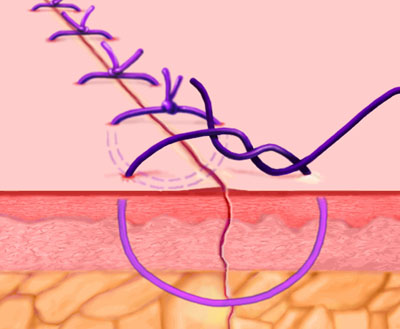
Interrupted Stitch
Each stitch is tied separately. May be used in skin or underlying tissue layers. More exact approximation of wound edges can be achieved with this technique than with the running stitch

Purse String
A continuous stitch paralleling the edges of a circular wound. The wound edges are inverted when tied. Commonly used to close circular wounds, such as hernia or an appendiceal stump
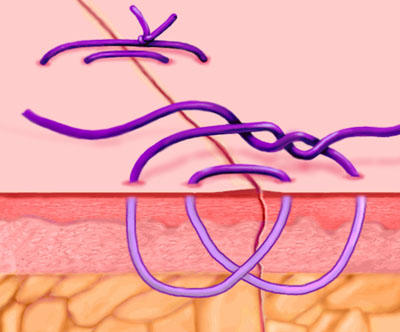
Smead-Jones/Far-and-Near
A double loop technique alternating far and near stitches, and possessing greater mechanical strength than continuous or simple interrupted sutures. Commonly used for approximating fascial edges, especially for patients at risk for fascial disruption or infection
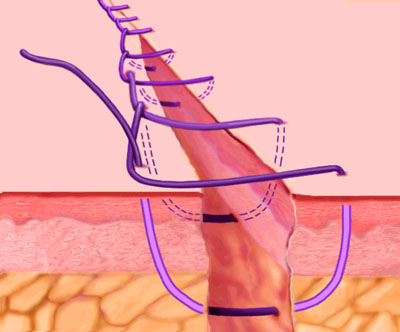
Continuous Locking, or Blanket Stitch
A self-locking running stitch used primarily for approximating skin edges
انواع نخ ها
Polypropylene: a nonabsorbable, monofilament material that is the least reactive of all suture materials; it is used with continuous percutaneous suturing. Its disadvantage is that it has coiled memory, making it difficult to handle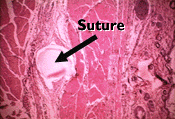
Nylon: a nonabsorbable suturing material that degrades in vivo by hydrolysis at a rate of about 125% annually. The advantages of nylon are good pliability and ease of handling. It is favored for interrupted percutaneous suture closures. Nylon sutures are available in monofilament and multifilament construction. Braided nylon sutures possess the same handling and knot construction characteristics as silk sutures, but unlike natural fiber, nylon is relatively nonreactive in tissue
Synthetic absorbable: absorbable refers to the degradation and loss of tensile strength within 60 days. Absorption and loss of tensile strength are not interchangeable. The former is important only with regard to late suture complications; the latter speaks to the primary function of the suture -- maintaining tissue approximation
Braided synthetic absorbable: useful for interrupted dermal suture and ligating bleeders
Monofilament synthetic absorbable: indicated for continuous dermal suture
تصاویر و تکنیک های قشنگی است ببینید!
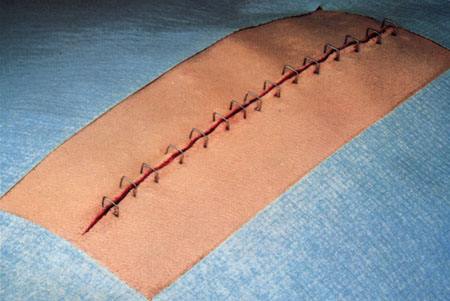
Staples
Staples are less reactive than the least reactive suture. Deeply implanted staples do not affect tissue defenses, although staple cross members that are flush with the skin can produce cross-hatched scarring. The development of disposable staplers with absorbable tacks obviates the need for removal of staples. Subcuticular closure of skin is now also possible through the use of a disposable stapler that uses twin gripper blades to approximate and evert the wound edges and insert a disposable pin into the dermis

Tape is the least reactive of man-made wound closure materials. Tape with hypoallergenic adhesive on spun bonded nylon without reinforcing filaments has the best record for avoiding premature detachment. It also reduces the incidence of stress blister formation
|
|
Types of Wound Closure: |
|
| |
|
|
Open-heart surgery on a child with a congenital heart defect 2
سلام این هم ۱۴ عکس دوم.از راست به چپ.














Open-heart surgery on a child with a congenital heart defect
سلام امروز می خواهم تصاویری واقعی از یک عمل جراحی قلب باز را در یک کودک بررسی کنیم.
امیدوارم که بپسندید.این عمل شامل ۲۶ عکس است و ۱۲ عکس را در مرحله اول می گذارم از عکس ۶ که عمل کاملا آغاز شده در هر سطر ۲ عکس گذاشتم تا با وضوح بیشتر ببینید.خوب ببینید چون شاید دیگر فرصتی برایتان تکرار نشود تا یک جراحی قلب باز را روی یک بچه با نارسایی ارثی-مادرزادی ببینید.












این از ۱۲ اسلاید اول ۱۴ اسلاید دیگر باقی است که انشاالله امشب می گذارمشان
امروز قسمت نظر دهی را باز می گذارم که در صورت تمایل نظر بگذارید.
چربیهای خون، کلسترول و تریگلیسیرید
|
چربیهای خون – کلسترول و تریگلیسیرید
| |||||||||||||||||||||||||||||||||||
| کلسترول چیست و انواع آن کدامند؟ | |||||||||||||||||||||||||||||||||||
| کلسترول، نوعی چربی است که در ساختمان کلیه سلولهای بدن بکار رفته است. این ماده ممکن است در کبد، از چربیهای اشباع شده ساخته شود یا اینکه از طریق مصرف گوشت، تخممرغ و سایر مواد غذایی حیوانی وارد بدن گردد. کلسترول در داخل بدن، به صورتهای مختلفی منتقل میشود. موادی بنام لیپوپروتئینها، کلسترول را در داخل خون، حمل میکنند. دو نوع اصلی لیپوپروتئینها عبارتند از لیپوپروتئین با چگالی کم (LDL) و لیپوپروتئین با چگالی زیاد (HDL LDL) عمدتاً مسئول انتقال کلسترول به بدن است و HDL، کلسترول را از جریان خون خارج میکند. بهمین دلیل، اگر افزایش کلسترول خون، بدلیل افزایش LDL باشد، توام با خطر بیماریهای قلبی – عروقی میباشد. مردان پس از ۳۵ سالگی و زنان پس از ۴۵ سالگی، باید سطح کلسترول خون خود را منظماً اندازهگیری نمایند. | |||||||||||||||||||||||||||||||||||
| تصویر | |||||||||||||||||||||||||||||||||||
 | |||||||||||||||||||||||||||||||||||
| جدول | |||||||||||||||||||||||||||||||||||
|
| |||||||||||||||||||||||||||||||||||
| |||||||||||||||||||||||||||||||||||
